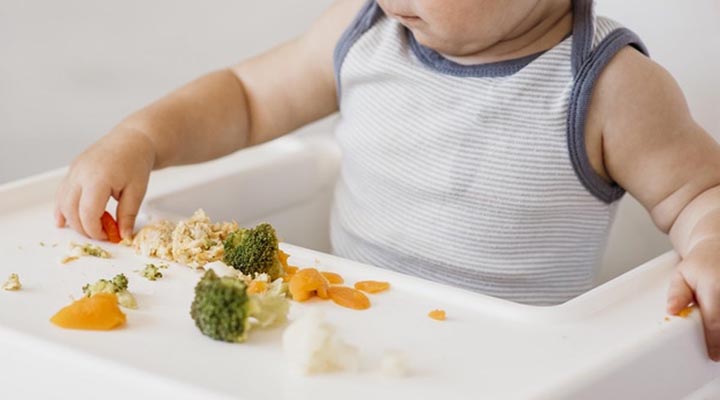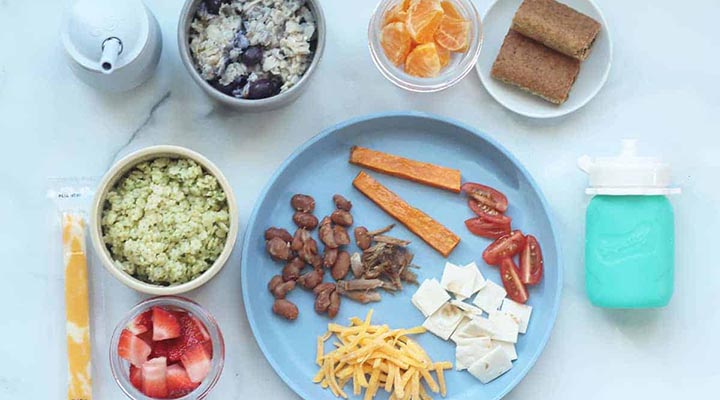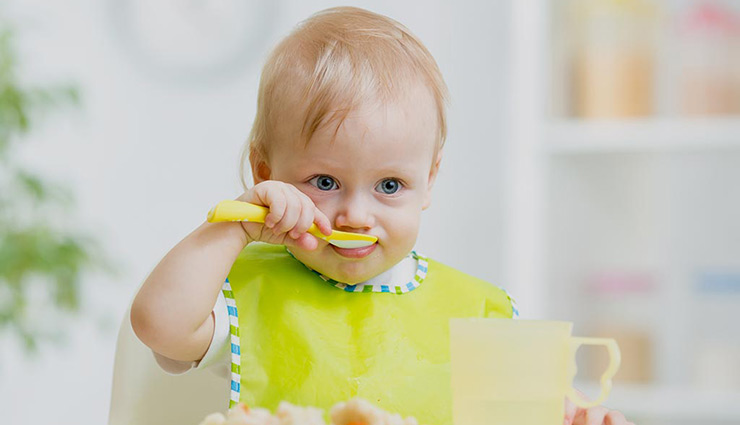If you’re trying to wean your baby, especially if it’s your first, you’re likely entering uncharted territory. Proper planning for feeding a one-year-old baby is confusing. Many parents don’t know when to wean a baby or what a baby’s diet should look like to start solid foods. Read more about one-year-old baby food and how to plan for it.
Appropriate number and time of meals
Most one-year-old children should eat three main meals and two snacks every day. The child has a lot of activity at this age, but his stomach is small, so he should have more dinners than adults to provide the energy he needs.
It is also better not to wait for the child’s request and always give your child meals and snacks regularly. When you want to start solid food and feed your baby five times a day, it is better to include solid foods in the snacks.
A one-year-old child’s snack
In addition to breakfast, lunch, and dinner, a mid-morning snack and a mid-evening snack are required. In these two snacks, use solid foods to feed the child. You can add a third snack if the distance between the main meals is long.
Set a meal plan for the child according to his sleeping time. For example, a child who wakes up early may need a snack before the rest of the family is ready for breakfast. Also, children who cannot eat much during dinner and stay awake for a long time after dinner may need a snack before bed.
Once you’ve set meal and snack times, stick to the schedule. If you feed your baby at set times, he will not be restless due to hunger. Also, the meal plan lets the child know when the next meal will be, so he does not constantly ask for snacks.
Use the program below to get started and modify it based on your child’s needs.
- 7:30 am to 8:00 am: Breakfast
- 10 to 10:30 am: Morning snack
- 12:30 pm: Lunch
- 3 to 3:30 pm: Evening snack
- 5:30 to 6 pm: Dinner
If your toddler wakes up very early, you can give him a pre-breakfast snack right after he wakes up. Cereal biscuits with a glass of milk or a banana are good options for this snack.
If your child sleeps late at night and has more than an hour between dinner and bedtime, you can give him a small snack. For this snack, you should choose something your child doesn’t like more than dinner, and it should also be a recurring snack. Otherwise, the child will learn that there is a lovely snack and will not finish his dinner.
The amount of food for a one-year-old child
Because you have a meal plan, you shouldn’t expect your toddler to eat the same amount daily at every meal. Overeating in one meal and not having enough appetite for the next dinner is normal behavior for a toddler, and this behavior is observed in most of them. Sometimes they may have no need and want to skip a meal altogether. This behavior is entirely normal.
So if you’re wondering how much you should feed your toddler at each meal, the answer is: as much as he’s satisfied. Always put a smaller amount of food on the plate instead of filling the container, and if your child is not happy with this amount, offer him more food. Don’t forget that your toddler’s stomach is small.
This list contains the appropriate amount of some foods in one meal for a one-year-old child:
- 1 to 3 cereal biscuits;
- A quarter of a cup of cooked cereal or pasta ;
- One medium piece of fresh fruit;
- One small amount of raw vegetable;
- a third of a cup of yogurt;
- half a cup of milk;
- One egg;
- 30 to 60 grams of meat;
- One tablespoon of peanut butter with half a slice of toast.
If the amount of each of these foods seems very small, you should know that the size of a toddler’s stomach is about a quarter of the size of an adult’s stomach. Due to this difference, a toddler will likely be satisfied by eating each of these foods based on the recommended amount.
You can use the list above to start a meal plan and modify it based on your child’s needs. Do not forget that children are different from each other, and these differences cause their nutritional needs to be different.
Are toddlers eating enough?
You might be surprised, but your toddler knows how much to eat. Children eat entirely based on hunger and fullness; they eat when hungry and usually stop eating when they are full. When you compare your baby’s food with yours, you may think he is not eating enough, but don’t worry because your toddler is eating as much as he needs.
How to tell if a toddler is eating enough?
If your baby is growing well, you don’t have to worry about him eating enough. You should include all food groups in meals and snacks to ensure your child gets all the necessary nutrients. By following this point, you will not only be sure that your child eats enough, but you will also be sure of the excellent quality of his food.
Anorexia of toddlers

If your child has no appetite for a meal or snack, don’t force him to eat. When your baby feels full, don’t pressure him to eat more. This behavior can have the opposite result because it teaches the child to ignore the signs of fullness, which causes overeating and then becoming overweight.
Of course, if your toddler doesn’t always have enough appetite to eat, you should check the amount of water or milk he drinks. Many liquids probably fill him up, and he doesn’t have enough need for the main meal or snack. Of course, there is nothing to worry about; you have to monitor his daily diet.
If your child eats various healthy foods throughout the day, skipping meals or snacks is okay. If your baby is growing, gaining weight, and becoming more active, ensure he’s getting enough to eat.
One-year-old baby food list
Parents’ biggest concern about the food of a one-year-old child is which foods are suitable for him. You can take help from the following lists, which are categorized according to food groups.
A one-year-old child should be able to eat foods prepared in pieces, chopped, mashed, or finger foods by themselves.
1. the vegetables
This list includes vegetables that are suitable for one-year-old baby food:
- Asparagus ;
- Broccoli;
- Squash;
- Cabbage;
- carrots;
- Cauliflower;
- green beans;
- Cabbage;
- Peas (green peas);
- Bell pepper;
- spinach;
- Zucchini.
You can cook the vegetables until they are soft, if necessary, and then prepare them in chopped or finger food form.
2. Fruits
This list includes fruits that are suitable for a one-year-old baby and are likely to enjoy eating them:
- avocado;
- Apple;
- the banana;
- blueberry;
- Kiwi;
- mango;
- Colored;
- Nectar
- Orange;
- Peach;
- Pink;
- Pineapple;
- potatoes;
- Raspberries;
- Strawberry.
Be sure to wash the fruits, remove the hard skin and remove the seeds. Then you can prepare the fruits in pieces, chopped, and even finger food.
3. Starchy foods
Suitable starchy foods for a one-year-old child include:
- Rice-based baby food;
- Bread;
- corn;
- who else;
- Pasta;
- meek;
- potato;
- quinoa seeds ;
- Rice;
- sweet potato.
After cooking, you can prepare the food listed above as chopped, mashed, or finger food. If your baby is over 12 months old, you can mix cooked cereal with pasteurized cow’s milk, but you should prepare this mixture with breast milk before the age of one year.
4. Protein foods

The child needs this food group to grow. Protein foods include all kinds of meat, eggs, and legumes; you can add these foods to your baby’s diet from 6 months.
Of course, besides a large amount of protein, these foods contain other nutrients, such as zinc and iron, necessary for the child’s growth.
5. dairy
Pasteurized dairy products are suitable for 6-month-old children. The best option for these babies is plain and high-fat flavored yogurt because sugary ingredients are not added to this type of yogurt. Of course, pasteurized cheese is also a good option. After six months, you can use pasteurized cow’s milk when cooking for your baby. Of course, it is not recommended to use pasteurized cow’s milk as a drink before one year of age.
A few important points
- Breastfeeding can continue as long as the baby and the mother both want.
- You don’t need to add sugar or salt to your toddler’s food; Sweet foods cause tooth decay, and salty foods harm the kidneys.
- Sweet drinks such as soft drinks, juice, and milkshakes are unsuitable for babies because they contain a lot of sugar and cause tooth decay.
Conclusion
A one-year-old child is at an age when he experiences the feeling of hunger and fullness and wants to eat and do many other things by himself. On the other hand, the child at this age goes through essential stages of development, and special attention to his nutrition is necessary.
It’s not easy for parents to go through this stage of baby’s growth and change, but luckily there are many foods and nutrients available to you that you can include in your one-year-old baby’s diet, from steamed vegetables and soft fruits to eggs and legumes.
Always prepare your child’s foods and meals in separate portions and small amounts. By doing this, you will not only find out which foods your child likes the most but also detect any food intolerances, allergies, and even more severe problems, and you can eliminate the cause of these problems from your child’s diet.
Do not forget that the appetite of babies and toddlers is not the same on all days, meals, and snacks and does not have a specific pattern. Also, children may need to try a new food several times to accept it into their diet, so don’t eliminate any food after trying it once.
Warning! This article is only for educational purposes; to use it, it is necessary to consult a doctor or specialist.



